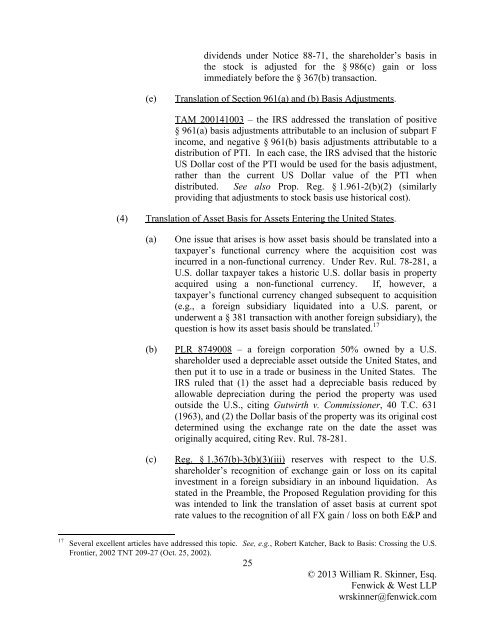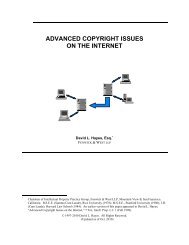International Tax Aspects of Foreign Currency Transactions
International Tax Aspects of Foreign Currency Transactions
International Tax Aspects of Foreign Currency Transactions
You also want an ePaper? Increase the reach of your titles
YUMPU automatically turns print PDFs into web optimized ePapers that Google loves.
dividends under Notice 88-71, the shareholder’s basis inthe stock is adjusted for the § 986(c) gain or lossimmediately before the § 367(b) transaction.(e)Translation <strong>of</strong> Section 961(a) and (b) Basis Adjustments.TAM 200141003 – the IRS addressed the translation <strong>of</strong> positive§ 961(a) basis adjustments attributable to an inclusion <strong>of</strong> subpart Fincome, and negative § 961(b) basis adjustments attributable to adistribution <strong>of</strong> PTI. In each case, the IRS advised that the historicUS Dollar cost <strong>of</strong> the PTI would be used for the basis adjustment,rather than the current US Dollar value <strong>of</strong> the PTI whendistributed. See also Prop. Reg. § 1.961-2(b)(2) (similarlyproviding that adjustments to stock basis use historical cost).(4) Translation <strong>of</strong> Asset Basis for Assets Entering the United States.(a)(b)(c)One issue that arises is how asset basis should be translated into ataxpayer’s functional currency where the acquisition cost wasincurred in a non-functional currency. Under Rev. Rul. 78-281, aU.S. dollar taxpayer takes a historic U.S. dollar basis in propertyacquired using a non-functional currency. If, however, ataxpayer’s functional currency changed subsequent to acquisition(e.g., a foreign subsidiary liquidated into a U.S. parent, orunderwent a § 381 transaction with another foreign subsidiary), thequestion is how its asset basis should be translated. 17PLR 8749008 – a foreign corporation 50% owned by a U.S.shareholder used a depreciable asset outside the United States, andthen put it to use in a trade or business in the United States. TheIRS ruled that (1) the asset had a depreciable basis reduced byallowable depreciation during the period the property was usedoutside the U.S., citing Gutwirth v. Commissioner, 40 T.C. 631(1963), and (2) the Dollar basis <strong>of</strong> the property was its original costdetermined using the exchange rate on the date the asset wasoriginally acquired, citing Rev. Rul. 78-281.Reg. § 1.367(b)-3(b)(3)(iii) reserves with respect to the U.S.shareholder’s recognition <strong>of</strong> exchange gain or loss on its capitalinvestment in a foreign subsidiary in an inbound liquidation. Asstated in the Preamble, the Proposed Regulation providing for thiswas intended to link the translation <strong>of</strong> asset basis at current spotrate values to the recognition <strong>of</strong> all FX gain / loss on both E&P and17Several excellent articles have addressed this topic. See, e.g., Robert Katcher, Back to Basis: Crossing the U.S.Frontier, 2002 TNT 209-27 (Oct. 25, 2002).25© 2013 William R. Skinner, Esq.Fenwick & West LLPwrskinner@fenwick.com
















